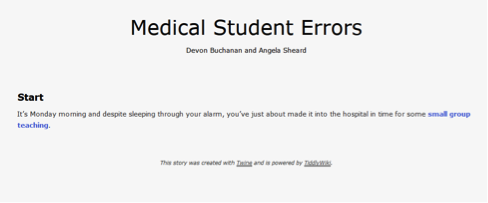Errordiary has stepped into the world of persuasive games! These are games designed to make you think. Here games are used as a medium to communicate a message, to challenge players’ assumptions, to expand people’s perspectives, and to encourage them to reflect on serious ethical and societal issues.
CHI+MED held a student game design competition in 2014. Over two months, teams were challenged to create a persuasive game that would get people reflecting on the causes of human error and raise awareness of blame culture within a healthcare context. The winners were selected through a combination of expert judging and testing with a group of players. We’ve outlined four games below and invite you to play them.
![]() Nurse’s Dilemma won First prize in the competition and was also awarded the People’s Choice award at the prize-giving an showcase in May. It was created by Adam Afghan, , Natasha Trotman and Jining (Kea) Zhang. The player is cast in the role of a nurse faced with a series of challenges during her daily tasks. The result is a compelling experience that fosters a sense of empathy and links back to issues surrounding human error and blame culture. While the choices may seem daunting, unfortunately these daily dilemmas are more common than you might think while staffing levels have led to increasing concern about care left undone. This game uses the Unity3D player which you need to have before you can play it. Play Nurse’s Dilemma
Nurse’s Dilemma won First prize in the competition and was also awarded the People’s Choice award at the prize-giving an showcase in May. It was created by Adam Afghan, , Natasha Trotman and Jining (Kea) Zhang. The player is cast in the role of a nurse faced with a series of challenges during her daily tasks. The result is a compelling experience that fosters a sense of empathy and links back to issues surrounding human error and blame culture. While the choices may seem daunting, unfortunately these daily dilemmas are more common than you might think while staffing levels have led to increasing concern about care left undone. This game uses the Unity3D player which you need to have before you can play it. Play Nurse’s Dilemma

St. Error Hospital was the competition Runner-up. It was created by Charmian Dawson and Subhan Shaffi. As opposed to Nurse’s Dilemma, which focuses on an individual nurse experience, St. Error Hospital utilises a bird’s eye view from a management perspective. Players can direct staff, organise ward areas and implement resilience strategies to reduce the chances of errors occurring. Through having to manipulate multiple variables, the game illustrates how errors relate to wider systemic issues and also highlights ways in which safety can be improved e.g. through improving training and creating a good work environment. Play St. Error Hospital

Patient Panic was created by Cameron Kyle-Davidson, Lydia Pauly, Benjamin Williams and Connor Wood. The game is set during a natural disaster where the player takes on the role of a local doctor who was to treat multitudes of patients before it’s too late. Through increasing difficulty levels, the player experiences increasing stress as they move from efficient care to damage control and unfortunate failure. While you can always try for a higher score in the game, the final slides illustrate how blame culture ensures that medical staff don’t always get a second chance in the real world. The Patient Panic team are continuing to work on their game, you can check their progress on Github. Play Patient Panic

Medical Student Errors was created by Devon Buchanan and Angela Sheard. It is an interactive fiction about a day in a life of a junior doctor. The game looks at how people make and communicate about errors, both professionally and in everyday life. The player can move backwards and forwards through the game, exploring different dialogue options and finding out more about different issues through clicking on hyper-links. While the game is particularly relevant to medical students, the final scene offers us all a chance to reflect on our behaviour towards others as well as on the different aspects of human error and blame culture explored within the game. Play Medical Student Errors

Together, these are an ambitious set of persuasive games that show different approaches to the same challenge. What sort of persuasive games would you have made? If you would like to find out more about human error then please have a look at the rest of our Discovery Zone. If you have any questions about the competition, please contact Jo Iacovides ().

These games are licensed under a Creative Commons Attribution-NonCommercial 4.0 International License.